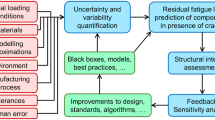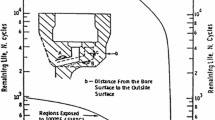Abstract
The procedures used in high temperature plant assessment are mostly deterministic thus requiring appropriate, specific data input to determine the remaining life of components containing design allowable defects. However, because high temperature test data contain uncertainties and scatter by their nature, the life assessment predictions may differ largely. In most cases it is based on the worst combination of input data resulting in a high conservative prediction. Thus achieved predictions do not take any optimisation of costs or improvement of plant efficiency into account. The present paper reports on the assessment procedures and the sources of scatter in creep/fatigue crack growth data. Their impact on the life assessment of the engineering structures following the deterministic and probabilistic methods is reported.
Similar content being viewed by others
References
Dogan B., Nikbin K., Webster G.A, Ceyhan U., Petrovski B., Dean D.W. Ainsworth R.A., Chapuliot S., Holdsworth S.: Code of practice for high temperature crack initiation and growth testing of weldments, IIW Doc., Res. XI #1, Submitted to IIW SC STAND for ISO standardisation, 2005.
Jovanovic A., Colantoni D., Balos D., Wagemann G., Le Mat Hamata N., Deschanels H.: Alias-HIDA, A knowldge-based system for probabilistic and sensitivity analysis of creep and fatigue crack growth in high temperature components, OMMI (www.ommi.co.uk), August 2004, Vol. 3, Issue 2.
Yatomi M., Nikbin K.: Life management in creep/fatigue using deterministic and probabilistic modeling, EPRI, Conference on “Life Management”, Orlando, March 2002.
Anderson T.W., Finn J.D.: The new statistical analysis of data, 96 Edition, Springer Verlag, December 1996.
R5, Assessment procedure for the high temperature response of structures, Issue 3, British Energy Generation, Gloucester 2003.
Ainsworth R.A.: Sensitivity analysis in creep crack growth — British Energy Experience, Int. HIDA — 4 Conf., Cambridge, UK, 20–22 Sept. 2004.
Dogan B., Petrovski B.: Creep crack growth of high temperature weldments, Int. Journal of Pressure Vessels and Piping, 2001, Vol. 78, pp. 795–805.
ASTM E1457–00, Standard test method for measurement of creep crack growth rates in metals, ASTM 03.01, Philadelphia: ASTM 2000, PA 19103, USA.
ESIS TC11 High Temperature Mechanical Testing Committee (HTMTC), Working Group on High Temperature Testing of Weldments.
Dogan B., Horstmann M.: Laser scanner displacement measurement at high temperatures, Int. Journal of Pressure Vessels and Piping, 2003, Vol. 80, pp. 427–434.
Dogan B., Petrovski B., Ceyhan U.: Significance of creep crack initiation for defect assessment, Proc. Int. Conf. BALTICA VI on Life Management and Maintenance for Power Plants, Eds J Veivo and P Auerkari, VTT Symp. 234, 2004, Vol. 2, Espoo, Finland, pp. 595–607.
Joensson M., Le Mat Hamata N., Concari S., Vrhovac M., Albuquerque J.M., Deschanels H., Proc. Int. HIDA-4 Conf., Churchill College, Cambridge, UK, 21–22 Sept. 2004, Eds. N. Le Mat Hamata and I.A. Shibli, 2004, pp. 3.1–3.15.
Ainsworth R.A., Cosso G.L., Dogan B., Holdsworth S., Korous J., Marcelles I., Mueller F.: An overview of the creep module of the FITNET FFS Procedure, Proceedings of the International Conference on Fitness-for-Service FITNET 2006, 17–19 May 2006 Amsterdam, Ed. by M. Koçak, GKSS Publications, ISBN 978-3-00-021084–6, 2007.
ECCC — Advanced Creep Project, Procedures, Vol. 9, part 2, ETD, UK, 2005.
Dogan B., Ceyhan U.: High temperature failure assessment of weldments, ECF16, due 3–7.7.2006, Alexandroupolis, Greece.
Mueller F., Scholz A., Berger C.: J. ASTM Int., April 2005, Vol. 2, No. 4, pp. 1–16.
Korous J.: Probabilistic reliability assessment of piping systems (in Czech), Proc. of Conf. Structural Reliability, Ostrava, CZ, 2005, pp. 181–186.
R6, Assessment of integrity of structures containing defects, Procedure R6, Revision 3, Gloucester, UK: Nuclear Electric Ltd., 1997.
Dieter G.: Mechanical Metallurgy, McGraw-Hill Science/Engineering/Math, 1986.
Ewald J., Keienburg G.: A two criteria diagram for creep crack initiation, Int. Conf. Creep, Tokyo, 173–178, April 1986.
Author information
Authors and Affiliations
Rights and permissions
About this article
Cite this article
Dogan, B., Ceyhan, U., Korous, J. et al. Sources of Scatter in Creep/Fatigue Crack Growth Testing and Their Impact on Plant Assessment. Weld World 51, 35–46 (2007). https://doi.org/10.1007/BF03266584
Published:
Issue Date:
DOI: https://doi.org/10.1007/BF03266584




